(完整word)高考英语主谓一致完全解析及高考真题
高中英语主谓一致含习题及讲解(推荐文档)
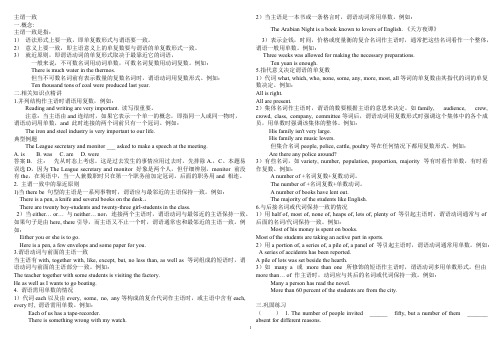
主谓一致一.概念:主谓一致是指:1)语法形式上要一致,即单复数形式与谓语要一致。
2)意义上要一致,即主语意义上的单复数要与谓语的单复数形式一致。
3)就近原则,即谓语动词的单复形式取决于最靠近它的词语, 一般来说,不可数名词用动词单数,可数名词复数用动词复数。
例如: There is much water in the thermos. 但当不可数名词前有表示数量的复数名词时,谓语动词用复数形式。
例如: Ten thousand tons of coal were produced last year.二.相关知识点精讲1.并列结构作主语时谓语用复数,例如: Reading and writing are very important. 读写很重要。
注意:当主语由and连结时,如果它表示一个单一的概念,即指同一人或同一物时,谓语动词用单数,and 此时连接的两个词前只有一个冠词。
例如: The iron and steel industry is very important to our life.典型例题 The League secretary and monitor ___ asked to make a speech at the meeting.A. isB. wasC. areD. were答案B. 注:先从时态上考虑。
这是过去发生的事情应用过去时,先排除A.,C。
本题易误选D,因为The League secretary and monitor 好象是两个人,但仔细辨别,monitor 前没有the,在英语中,当一人兼数职时只在第一个职务前加定冠词。
后面的职务用and 相连。
2. 主谓一致中的靠近原则1)当there be 句型的主语是一系列事物时,谓语应与最邻近的主语保持一致。
例如: There is a pen, a knife and several books on the desk.。
高考英语新主谓一致知识点真题汇编含答案
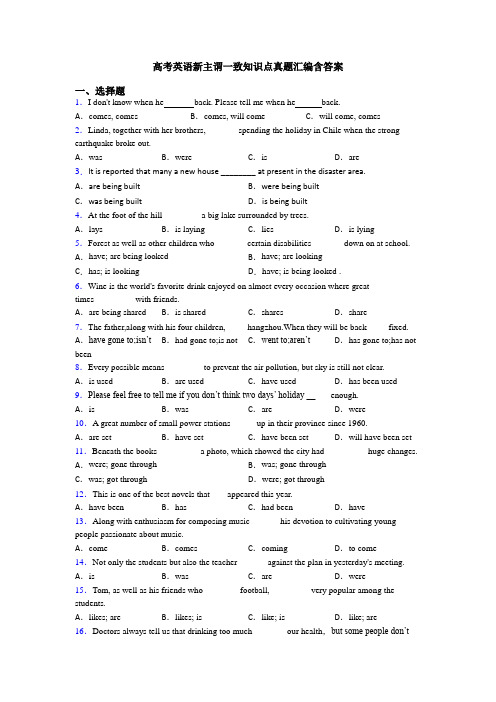
高考英语新主谓一致知识点真题汇编含答案一、选择题1.I don't know when he back. Please tell me when he back.A.comes, comes B.comes, will come C.will come, comes 2.Linda, together with her brothers, _______spending the holiday in Chile when the strong earthquake broke out.A.was B.were C.is D.are3.It is reported that many a new house ________ at present in the disaster area.A.are being built B.were being builtC.was being built D.is being built4.At the foot of the hill ________ a big lake surrounded by trees.A.lays B.is laying C.lies D.is lying 5.Forest as well as other children who _______certain disabilities _______down on at school. A.have; are being looked B.have; are lookingC.has; is looking D.have; is being looked .6.Wine is the world's favorite drink enjoyed on almost every occasion where greattimes_________ with friends.A.are being shared B.is shared C.shares D.share7.The father,along with his four children,_____hangzhou.When they will be back_____fixed. A.have gone to;isn’t B.had gone to;is not C.went to;aren’t D.has gone to;has not been8.Every possible means ________ to prevent the air pollution, but sky is still not clear.A.is used B.are used C.have used D.has been used 9.Please feel free to tell me if you don’t think two days’ holiday _____ enough.A.is B.was C.are D.were10.A great number of small power stations _____ up in their province since 1960.A.are set B.have set C.have been set D.will have been set 11.Beneath the books _________ a photo, which showed the city had _________ huge changes. A.were; gone through B.was; gone throughC.was; got through D.were; got through12.This is one of the best novels that____appeared this year.A.have been B.has C.had been D.have13.Along with enthusiasm for composing music ______ his devotion to cultivating young people passionate about music.A.come B.comes C.coming D.to come14.Not only the students but also the teacher ______ against the plan in yesterday's meeting. A.is B.was C.are D.were 15.Tom, as well as his friends who________ football, _________very popular among the students.A.likes; are B.likes; is C.like; is D.like; are 16.Doctors always tell us that drinking too much________our health,but some people don’tcare.A.is harm to B.does harmful toC.is harmful to D.do harm to17.Once environment damage ________, it takes many years for the government to recover. A.has done B.is to do C.does D.is done 18.—How can I live my dreams in a short time?—Be practical. Between you and your dreams ________ a lot of hard work.A.stand B.standsC.is standing D.are standing19.Delete the short message at once! Many a man ______ by such tricks up to now.A.are cheated B.is cheatedC.have been cheated D.has been cheated20.Out to the finishing line…! And here !A.he dashes… comes our champion and heroB.dashes he… our champion and hero comeC.he dashes… come our champion and heroD.dashes he… comes our champion and hero21.The father along with his children ______ solving word puzzles.A.are like B.is like C.like D.likes22.A survey carried out last year showed that 80% of the middle-aged in this city ____________ in favour of the proposal on health care reform.A.is B.are C.was D.were23.Every boy and every girl _________ to attend the evening party.A.wish B.wishes C.hope D.are hoping 24.Mark Twa in’s The Adventures of Huckleberry Finn, one of the great American novels,________ first published in the United States in 1885.A.was B.were C.has been D.had been25.The dictionary as well as the grammar books that ________ bookmarks in them ________ Jane.A.has; belong to B.have; belongs toC.have; is belonged to D.has; are belonged to【参考答案】***试卷处理标记,请不要删除一、选择题1.C解析:C【解析】【分析】考查时态。
2024_2025三年高考英语真题分项汇编专题06动词的时态语态和主谓一致

专题06 动词的时态、语态和主谓一样2024年高考真题1.(2024新高考I卷)The plan will extend protection to a significant number of areas that __________ (be)previously unprotected,答案:were解析:考查时态和主谓一样。
句意:该安排将把爱护范围扩大到大量以前未受爱护的地区,将很多现有的大熊猫爱护区纳入一个管理机构,以提高效率,削减管理上的不一样性。
设空处在that引导的限制性定语从句中作谓语,先行词为a significant number of areas,先行词在从句中作主语,依据“previously (之前地)”可知从句的时态应为一般过去时,依据主谓一样,从句主语复数,从句谓语复数形式。
故填were。
2.(2024新高考I卷)After a three-year pilot period, the GPNP will be officially set up next year. The GPNP __________ (design)to reflect the guiding principle of “protecting the authenticity and integrity(完整性)of natural ecosystems, preserving biological diversity, protecting ecological buffer zones, and leaving behind precious natural assets(资产)for future generations”.答案:is designed解析:考查时态语态和主谓一样。
句意:GPNP旨在体现“爱护自然生态系统的真实性和完整性,爱护生物多样性,爱护生态缓冲区,为子孙后代留下珍贵的自然资产”的指导原则。
高考英语专题主谓一致知识点全集汇编附答案解析
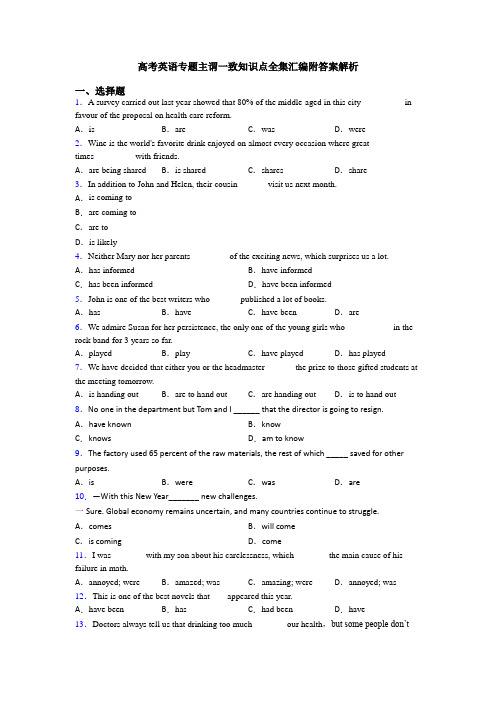
高考英语专题主谓一致知识点全集汇编附答案解析一、选择题1.A survey carried out last year showed that 80% of the middle-aged in this city _________ in favour of the proposal on health care reform.A.is B.are C.was D.were2.Wine is the world's favorite drink enjoyed on almost every occasion where greattimes_________ with friends.A.are being shared B.is shared C.shares D.share3.In addition to John and Helen, their cousin ______ visit us next month.A.is coming toB.are coming toC.are toD.is likely4.Neither Mary nor her parents ________ of the exciting news, which surprises us a lot. A.has informed B.have informedC.has been informed D.have been informed5.John is one of the best writers who ______ published a lot of books.A.has B.have C.have been D.are6.We admire Susan for her persistence, the only one of the young girls who __________ in the rock band for 3 years so far.A.played B.play C.have played D.has played7.We have decided that either you or the headmaster ______ the prize to those gifted students at the meeting tomorrow.A.is handing out B.are to hand out C.are handing out D.is to hand out 8.No one in the department but Tom and I ______ that the director is going to resign. A.have known B.knowC.knows D.am to know9.The factory used 65 percent of the raw materials, the rest of which _____ saved for other purposes.A.is B.were C.was D.are10.—With this New Year_______ new challenges.一Sure. Global economy remains uncertain, and many countries continue to struggle. A.comes B.will comeC.is coming D.come11.I was _______ with my son about his carelessness, which _______ the main cause of his failure in math.A.annoyed; were B.amazed; was C.amazing; were D.annoyed; was 12.This is one of the best novels that____appeared this year.A.have been B.has C.had been D.have 13.Doctors always tell us that drinking too much________our health,but some people don’tcare.A.is harm to B.does harmful toC.is harmful to D.do harm to14.—Lydia, what did our head-teacher say just now?—Every boy and every girl as well as the teachers who _____ to lead the group _____ asked to be at theschool gate before 6:30 in the morning.A.is; is B.are; are C.are; is D.is; are 15.Although there is more female participation in IT workforce,______ a significant imbalance of male and female senior positions.A.it remains B.there remainsC.there remaining D.that remains16.It is estimated that living expenses for international students in the university ________ around $9,000 a year, which ________ a heavy burden for some of them.A.is; is B.are; are C.is; are D.are; is17.At the station ______ a teacher and two students on their way to the city.A.were B.was C.is D.sits18.Every boy and every girl _________ to attend the evening party.A.wish B.wishes C.hope D.are hoping19.If you look at all sides of the situat ion, you’ll find probably a solution that ______ everyone. A.suit B.suited C.suits D.has suited20.A lot of new wooden furniture, as well as some latest household appliances, ________ by the Smiths for their new house a week ago.A.has been bought B.have been boughtC.was bought D.were bought21.Two-thirds of the coins dug up on the island ________ from the year 275AD to 221BC.A.dating B.date C.dates D.are dated22.The secretary and the manager ____very busy now.A.is B.are C.was D.were23.In our class of the students girls.A.third fifths; is B.third fifth; are C.three fifth; is D.three fifths; are 24.Not only the students but also the teacher ______ against the plan in yesterday's meeting. A.is B.was C.are D.were25.John as well as the other children who ______ no parents ______ good care of in the centre at present.A.has; is taken B.have; are taken C.have; is taken D.has; are taken 【参考答案】***试卷处理标记,请不要删除一、选择题1.D解析:D【解析】【分析】【详解】考查动词时态和主谓一致。
主谓一致用法详解及练习题-附答案
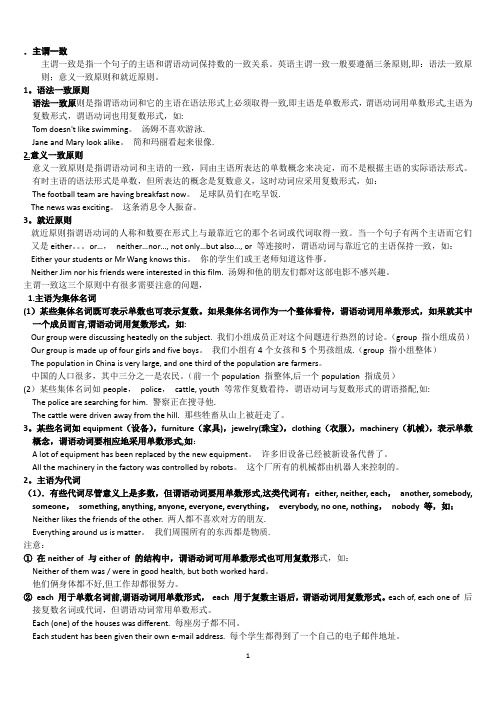
.主谓一致主谓一致是指一个句子的主语和谓语动词保持数的一致关系。
英语主谓一致一般要遵循三条原则,即:语法一致原则;意义一致原则和就近原则。
1。
语法一致原则语法一致原则是指谓语动词和它的主语在语法形式上必须取得一致,即主语是单数形式,谓语动词用单数形式,主语为复数形式,谓语动词也用复数形式,如:Tom doesn't like swimming。
汤姆不喜欢游泳.Jane and Mary look alike。
简和玛丽看起来很像.2.意义一致原则意义一致原则是指谓语动词和主语的一致,同由主语所表达的单数概念来决定,而不是根据主语的实际语法形式。
有时主语的语法形式是单数,但所表达的概念是复数意义,这时动词应采用复数形式,如:The football team are having breakfast now。
足球队员们在吃早饭.The news was exciting。
这条消息令人振奋。
3。
就近原则就近原则指谓语动词的人称和数要在形式上与最靠近它的那个名词或代词取得一致。
当一个句子有两个主语而它们又是either。
or…,neither…nor…, not only…but also…, or 等连接时,谓语动词与靠近它的主语保持一致,如:Either your students or Mr Wang knows this。
你的学生们或王老师知道这件事。
Neither Jim nor his friends were interested in this film. 汤姆和他的朋友们都对这部电影不感兴趣。
主谓一致这三个原则中有很多需要注意的问题,1.主语为集体名词(1)某些集体名词既可表示单数也可表示复数。
如果集体名词作为一个整体看待,谓语动词用单数形式,如果就其中一个成员而言,谓语动词用复数形式,如:Our group were discussing heatedly on the subject. 我们小组成员正对这个问题进行热烈的讨论。
2021年高三英语 语法专题主谓一致 Word版含答案
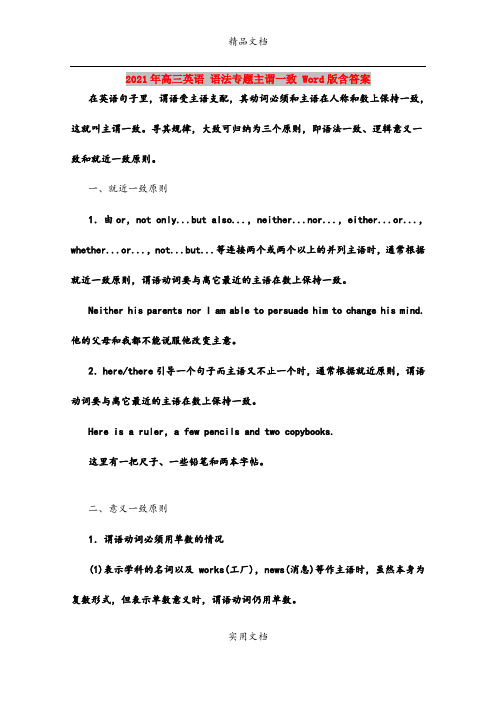
2021年高三英语语法专题主谓一致 Word版含答案在英语句子里,谓语受主语支配,其动词必须和主语在人称和数上保持一致,这就叫主谓一致。
寻其规律,大致可归纳为三个原则,即语法一致、逻辑意义一致和就近一致原则。
一、就近一致原则1.由or,not only...but also...,neither...nor...,either...or...,whether...or...,not...but...等连接两个或两个以上的并列主语时,通常根据就近一致原则,谓语动词要与离它最近的主语在数上保持一致。
Neither his parents nor I am able to persuade him to change his mind.他的父母和我都不能说服他改变主意。
2.here/there引导一个句子而主语又不止一个时,通常根据就近原则,谓语动词要与离它最近的主语在数上保持一致。
Here is a ruler,a few pencils and two copybooks.这里有一把尺子、一些铅笔和两本字帖。
二、意义一致原则1.谓语动词必须用单数的情况(1)表示学科的名词以及works(工厂),news(消息)等作主语时,虽然本身为复数形式,但表示单数意义时,谓语动词仍用单数。
Politics is his favorite subject.政治是他最爱的科目。
(2)表示某些组织机构的名词、书/报名、国名、地名等作主语时,虽然形式上是复数,但所表示的意义是单数,所以谓语动词用单数。
Do you know when the United Nations was set up?你知道联合国是什么时候建立的吗?2.谓语动词必须用复数的情况表示总称意义的名词,如people,police,public,cattle等作主语时,谓语动词用复数。
The police are searching for the murderer.警察正在搜捕杀人凶手。
高考英语语法总复习:主谓一致(附练习及答案)

一、专题引入(4 mins)在正式上课之前,我们先来句子纠错,看看你是否细心,是否还记得我们之前学过的知识。
1. Both boys has their own hobbies.2. The class is busy writing English passages.3. Neither you nor I are wrong.每个句子都有一个错误,错误点在于句子谓语动词的使用上,你能找出来吗?(校对答案:1. has- have 2. is – are 3. are – am 并请同学说明原因,考查这位同学是否掌握到位) 二、专题知识梳理(20 mins)知识点1:主谓一致三大考点知识点2:语法一致主语单复数决定谓语动词的单复数形式,即主语是单数,谓语用单数,主语是复数,谓语用复数。
例句:Tow students are waiting for you in your office. 两名学生在办公室等你。
Both girl are interested in listening to music. 两个女孩都对听音乐感兴趣。
1-5 A A B D D6-10 C C A C A【分析】同学需要特别注意的是语法一致,意义一致和就近原则知识点表格上的内容,需要熟记并运用。
五、学法提炼(2 mins)1、专题特点:主谓一致专题的知识点理解较易,但难点在于熟记表格中的每种情况,并能够熟练运用到做题当中去。
2、解题方法:分类熟记知识点表格。
3、分析事项:在考试中,主谓一致中的三个考点是混合出现的,同学必须熟练掌握三个考点各自的内容,以及熟记。
建议课后对知识点条目进行背诵。
一、专题引入(1 mins)上面我们复习了非谓语动词中语法一致的内容,接下来我们继续复习意义一致和就近原则的知识。
二、专题知识梳理(15 mins)知识点1:意义一致情况例句1. 有些集体名词既可以表示单数,又可以表示复数,这类集体名词作主语时,如果它们所表示的人或物是作为一个整体来理解,谓语动词用单数形式;如果作为若干个体来理解,则谓语动词用复数形式这些词有:family, class, crowd, team, group等【注意】people,police等名词一般做复数用1. Class 4 is on the third floor.2. Class 4 are studying in the classroom.3. The police are looking for the lost child.2. 主语是书名,片名,格言,剧名,报名,国名等的复数形式,谓语动词一般ongoing单数形式1. Gone with the wind is an interesting book.3. 表示“时间,重量,长度,价格”等的名词的复数做主语时,谓语动词用单数形式1. Thirty minutes is enough for the work.4. 一些学科名词以-ics 结尾,如:mathematics,politics,physics等,都属于形式上是复数名词,实际意义为单数名词,它们做主语时,谓语动词用单数形式1. Some teachers says that physics is difficult for students to study.5. “the+形容词”表类别、一类人或物,当它表示一类人 1. The rich are not always happy.1-5 A C D B D6-10 C C A C A【分析】同学需要特别注意的是语法一致,意义一致和就近原则知识点表格上的内容,需要熟记并运用。
(完整版)高考英语专题复习主谓一致(附答案).doc

(完整版)高考英语专题复习主谓一致(附答案).doc高考英语专题复习主谓一致(附答案)I.考点分析一、概述主谓一致是指句子成分之间或词语之间在人称、性、数等方面的一致关系。
处理主谓一致一般应遵循以下三条原则:1.语法一致,即在语法形式上取得一致。
例如,主语为单数形式,谓语动词也为单数形式;主语为复数形式,谓语动词也采取复数形式。
a. The number of errors was surprising.b. Julia and her twin sister naturally look a lot alike.2.意义一致,即从意义着眼处理一致关系。
a. The crowd were fighting for their lives. (单形名词主语要求复数谓语动词,下划线部分表示一个整体中的成员 )b. Five minutes is enough. ( 复数名词单数谓语动词,下划线部分表示一个数目)3.邻近原则,即指谓语动词的形式与邻近的名词一致。
a. A man of abilities are needed(.动词 are 不与主语 a man一致,而与其邻近的复形名词a bilities 形式上一致。
二、主谓一致注意要点:1.当名词词组中心词为表示度量、时间等复数名词时,往往可根据意义一致的原则,把这些复数名词看作一个整体,谓语动词采取单数形式。
a. The dollars is not enough.b. Three months passes in no time at all on the ranch.如果明显地指一个个个体,则要根据语法一致地原则,谓语动词用复数形式。
a. There are two sliver dollars in each of the stockings.2.如果名词词组中心词是all, most, half, the last, the rest, the remainder等词组时,其主谓关系一般遵循意义一致的原则:如所指为复数意义,谓语动词用复数形式;如所指为单数意义,则谓语动词用单数形式。
高考英语语法专题复习:主谓一致(含练习题及答案)
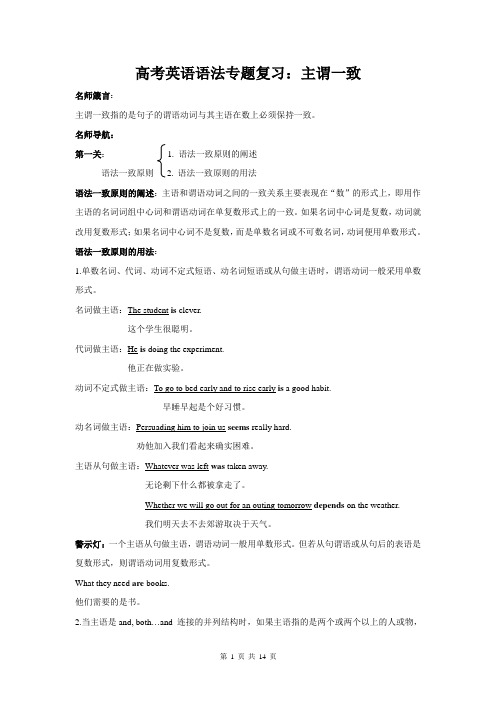
高考英语语法专题复习:主谓一致名师箴言:主谓一致指的是句子的谓语动词与其主语在数上必须保持一致。
名师导航:第一关: 1. 语法一致原则的阐述语法一致原则 2. 语法一致原则的用法语法一致原则的阐述:主语和谓语动词之间的一致关系主要表现在“数”的形式上,即用作主语的名词词组中心词和谓语动词在单复数形式上的一致。
如果名词中心词是复数,动词就改用复数形式;如果名词中心词不是复数,而是单数名词或不可数名词,动词便用单数形式。
语法一致原则的用法:1.单数名词、代词、动词不定式短语、动名词短语或从句做主语时,谓语动词一般采用单数形式。
名词做主语:The student is clever.这个学生很聪明。
代词做主语:He is doing the experiment.他正在做实验。
动词不定式做主语:To go to bed early and to rise early is a good habit.早睡早起是个好习惯。
动名词做主语:Persuading him to join us seems really hard.劝他加入我们看起来确实困难。
主语从句做主语:Whatever was left was taken away.无论剩下什么都被拿走了。
Whether we will go out for an outing tomorrow depends on the weather.我们明天去不去郊游取决于天气。
警示灯:一个主语从句做主语,谓语动词一般用单数形式。
但若从句谓语或从句后的表语是复数形式,则谓语动词用复数形式。
What they need are books.他们需要的是书。
2.当主语是and, both…and 连接的并列结构时,如果主语指的是两个或两个以上的人或物,谓语动词用复数。
Tom and Jack were close friends.汤姆和杰克是亲密的朋友。
Both rice and wheat are grown by farmers in China.中国的农民既种植大米也种植小麦。
主谓一致考点解析(Word版附答案)

主谓一致考点解析(Word版附答案)一、主谓一致1.Wechat(微信) is very popular. ____ the young ____ the old are getting interested in it. A.Neither; nor B.Either; orC.Not only; but also D.Between; and【答案】C【解析】试题分析:句意:微信很流行,不但年轻人而且老年人都对它感兴趣。
A. Neither…nor…:……既不……也不;B. Either…or 或者……或者……;C. Not only…but also 不但……而且……;D. Between…and介于……与……之间。
由“popular”(受欢迎的,流行的,大众的)可以推测出年轻人和老年人都感兴趣,故选C。
考点:考查连词辨析。
2. students in the classroom twenty. The others are in the library.A.The number of; isB.A number of; areC.The number of; are【答案】A【解析】试题分析:句意:教室里的学生人数是二十,其他的人在图书馆。
The number of ……的数量,谓语动词用单数;a number of大量的,谓语动词用复数。
The others其他的,表示复数,谓语动词用复数,结合题意故选A。
考点:考查主谓一致。
3.Not only you but also I __________ interested in the cartoon called Peppa Pig.A.am B.is C.are【答案】A【解析】【详解】考查句子的主谓一致。
句意:不仅是你,我也对卡通片《粉红猪小妹》感兴趣。
A. am用于主语是I的一般现在时;B. is用于主语是单数第三人称的一般现在时;C. are用于主语是复数的一般现在时。
近五年高考英语真题解析——主谓一致
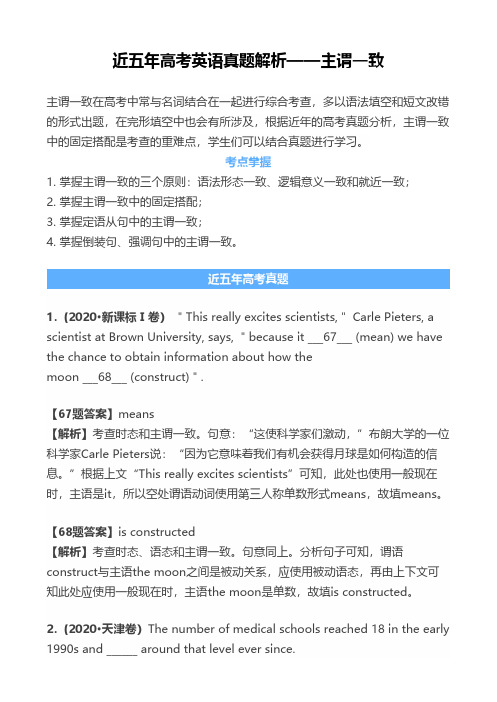
近五年高考英语真题解析——主谓一致主谓一致在高考中常与名词结合在一起进行综合考查,多以语法填空和短文改错的形式出题,在完形填空中也会有所涉及,根据近年的高考真题分析,主谓一致中的固定搭配是考查的重难点,学生们可以结合真题进行学习。
考点掌握1. 掌握主谓一致的三个原则:语法形态一致、逻辑意义一致和就近一致;2. 掌握主谓一致中的固定搭配;3. 掌握定语从句中的主谓一致;4. 掌握倒装句、强调句中的主谓一致。
1.(2020∙新课标Ⅰ卷) "This really excites scientists," Carle Pieters, a scientist at Brown University, says, "because it ___67___ (mean) we have the chance to obtain information about how themoon ___68___ (construct)".【67题答案】means【解析】考查时态和主谓一致。
句意:“这使科学家们激动,”布朗大学的一位科学家Carle Pieters说:“因为它意味着我们有机会获得月球是如何构造的信息。
”根据上文“This really excites scientists”可知,此处也使用一般现在时,主语是it,所以空处谓语动词使用第三人称单数形式means,故填means。
【68题答案】is constructed【解析】考查时态、语态和主谓一致。
句意同上。
分析句子可知,谓语construct与主语the moon之间是被动关系,应使用被动语态,再由上下文可知此处应使用一般现在时,主语the moon是单数,故填is constructed。
2.(2020∙天津卷)The number of medical schools reached 18 in the early 1990s and ______ around that level ever since.A.are remainingB.have remainedC.is remainingD.has remained【答案】D【解析】考查时态和主谓一致。
高考英语最新主谓一致知识点解析含答案

高考英语最新主谓一致知识点解析含答案一、选择题1.I was _______ with my son about his carelessness, which _______ the main cause of his failure in math.A.annoyed; were B.amazed; was C.amazing; were D.annoyed; was2.It is reported that many a new house ________ at present in the disaster area.A.are being built B.were being builtC.was being built D.is being built3.Wine is the world's favorite drink enjoyed on almost every occasion where greattimes_________ with friends.A.are being shared B.is shared C.shares D.share4._____ of the students who took part in the military training is 450.A.A number B.A lot C.A few D.The number 5.The father,along with his four children,_____hangzhou.When they will be back_____fixed. A.have gone to;isn’t B.had gone to;is not C.went to;aren’t D.has gone to;has not been6.The fact that so many people still smoke in public places____ that we may need a nationwide campaign to raise awareness of the risks of smoking.A.suggest B.suggests C.suggested D.suggesting 7.John is one of the best writers who ______ published a lot of books.A.has B.have C.have been D.are8.Actually, the garden, as well as the trees around it, a man living across the street.A.is belonged to B.are belonged to C.belongs to D.belong to9.We admire Susan for her persistence, the only one of the young girls who __________ in the rock band for 3 years so far.A.played B.play C.have played D.has played10.E-mail as well as telephones ______ more and more popular in daily communication. A.have become B.become C.are becoming D.is becoming 11.Please feel free to tell me if you don’t think two days’ holiday _____ enough.A.is B.was C.are D.were12.The people trapped in the ruins ____________ that rescue teams ____________ here without delay.A.desire; are sent B.desiring; were sentC.desire; be sent D.desiring; be sent13.—With this New Year_______ new challenges.一Sure. Global economy remains uncertain, and many countries continue to struggle. A.comes B.will comeC.is coming D.come14.— Why is the chemical plant closed?— Because large quantities of waste water ______ into the Yangtze River.A.has been released B.is being releasedC.was released D.have been released15.I don't know when he back. Please tell me when he back.A.comes, comes B.comes, will come C.will come, comes16.A survey carried out last year showed that 80% of the middle-aged in this city _________ in favour of the proposal on health care reform.A.is B.are C.was D.were17.The writer and poet________ to give us a speech on English study next week.A.are B.is C.was D.will be 18.Charles is crazy about antiques and included in his closet _____ a collection of vases in various shapes and sizes.A.has B.is C.have D.are19.At the station ______ a teacher and two students on their way to the city.A.were B.was C.is D.sits20.Every boy and every girl _________ to attend the evening party.A.wish B.wishes C.hope D.are hoping21.A lot of new wooden furniture, as well as some latest household appliances, ________ by the Smiths for their new house a week ago.A.has been bought B.have been boughtC.was bought D.were bought22.The secretary and the manager ____very busy now.A.is B.are C.was D.were23.In our class of the students girls.A.third fifths; is B.third fifth; are C.three fifth; is D.three fifths; are 24.The number of teenagers who commit crimes _________ 20% over the past years. A.have been reduced by B.has been reduced byC.have been reduced to D.has been reduced to25.The factory used 65 percent of the raw materials, the rest of which _____ saved for other purposes.A.is B.were C.was D.are【参考答案】***试卷处理标记,请不要删除一、选择题1.D解析:D【解析】【分析】【详解】考查形容词词义辨析和主谓一致。
高考英语主谓一致完全解析及高考真题

主语和谓语的一致(Agreement between subject and verb)⒈Definition: 主语要和谓语在人称和数上保持一致叫主谓一致。
⒉主谓一致包括三个原则:语法一致原则、意义一致原则和就近一致原则。
㈠语法一致原则:指用作主语的名词词组的中心词和谓语动词在单复数形式上的一致。
⑴介词短语with, as well as, including, except, except for, but, together, besides, rather than, along with, together with 等修饰主语时,谓语动词的数的形式与介词前面的名词或代词的人称和数保持一致。
e.g. I, along with my parents, am a football fan.The girl as well as boys likes playing basketball.⑵由each 和every 修饰的名词以及由every-, any-, some-, no- 构成的复合代词都当作单数,谓语动词用单数。
e.g. Every hour and every minute is important.Every boy and every girl enjoys the holiday.Someone is waiting for you.Everyone is here.Everything is ready.⑶动名词(短语),不定式(短语)和从句作主语,谓语动词用单数形式。
e.g. To see is to believe.Walking on the moon is very difficult.What he said is wrong.注:ⅰ. 在用形式主语it 的句中和在用it 作主语的强调句中,谓语动词总用单数。
e.g. It isn’t obvious who will be the best.It was he who taught us English last year.ⅱ. what 引导的主语从句,谓语一般用单数,但如果表示复数意义时谓语动词要用复数。
完整版最全的高中英语主谓一致讲解及练习精华版
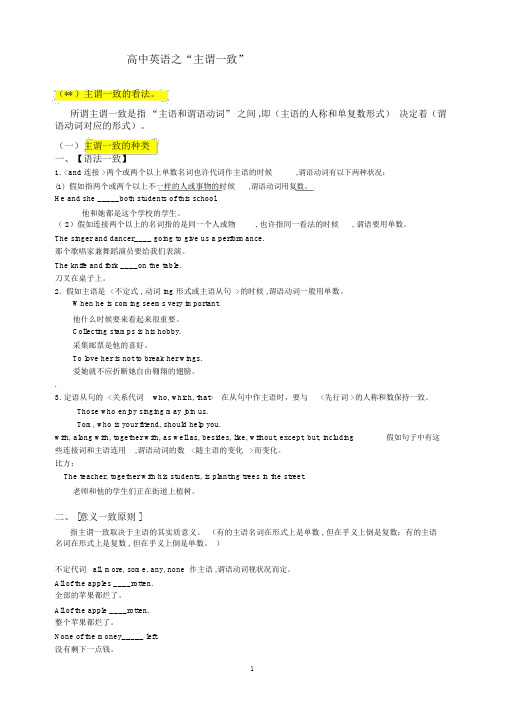
高中英语之“主谓一致”(** )主谓一致的看法。
所谓主谓一致是指“主语和谓语动词”之间 ,即(主语的人称和单复数形式)决定着(谓语动词对应的形式)。
(一)主谓一致的种类一、【语法一致】1. <and 连接 >两个或两个以上单数名词也许代词作主语的时候,谓语动词有以下两种状况:(1) 假如指两个或两个以上不一样的人或事物的时候,谓语动词用复数。
He and she _____both students of this school.他和她都是这个学校的学生。
( 2)假如连接两个以上的名词指的是同一个人或物, 也许指同一看法的时候, 谓语要用单数。
The singer and dancer____ going to give us a performance.那个歌唱家兼舞蹈演员要给我们表演。
The knife and fork ____on the table.刀叉在桌子上。
2.假如主语是 <不定式 , 动词 ing 形式或主语从句 >的时候 ,谓语动词一般用单数。
When he is coming seems very important.他什么时候要来看起来很重要。
Collecting stamps is his hobby.采集邮票是他的喜好。
To love her is not to break her wings.爱她就不应折断她自由翱翔的翅膀。
.3. 定语从句的 <关系代词who, which, that>在从句中作主语时,要与<先行词 >的人称和数保持一致。
Those who enjoy singing may join us.Tom, who is your friend, should help you.with, along with, together with, as well as, besides, like, without, except, but, including假如句子中有这些连接词和主语连用,谓语动词的数<随主语的变化>而变化。
高考英语主谓一致完全解析及高考真题
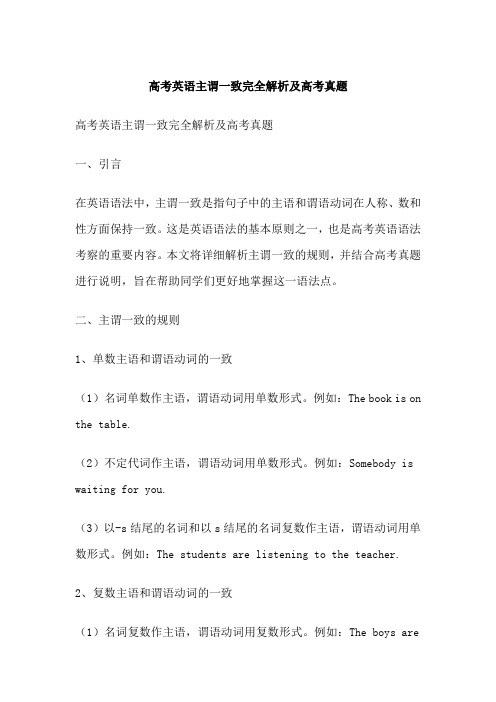
高考英语主谓一致完全解析及高考真题高考英语主谓一致完全解析及高考真题一、引言在英语语法中,主谓一致是指句子中的主语和谓语动词在人称、数和性方面保持一致。
这是英语语法的基本原则之一,也是高考英语语法考察的重要内容。
本文将详细解析主谓一致的规则,并结合高考真题进行说明,旨在帮助同学们更好地掌握这一语法点。
二、主谓一致的规则1、单数主语和谓语动词的一致(1)名词单数作主语,谓语动词用单数形式。
例如:The book is on the table.(2)不定代词作主语,谓语动词用单数形式。
例如:Somebody is waiting for you.(3)以-s结尾的名词和以s结尾的名词复数作主语,谓语动词用单数形式。
例如:The students are listening to the teacher. 2、复数主语和谓语动词的一致(1)名词复数作主语,谓语动词用复数形式。
例如:The boys areplaying football.(2)不定代词作主语,谓语动词用复数形式。
例如:Everybody is wearing a new dress.3、并列主语和谓语动词的一致并列主语指的是由and或or连接的两个或多个主语。
在这种情况下,谓语动词的形式取决于最靠近它的主语。
例如:John and Mary are good at swimming.(约翰和玛丽擅长游泳。
)4、主语从句、动名词和不定式作主语时的主谓一致(1)主语从句作主语时,谓语动词的形式取决于从句中的主语。
例如:What we need is more time.(2)动名词作主语时,谓语动词用单数形式。
例如:Reading books is my favorite hobby.(3)不定式作主语时,如果不定式的动作是可数的,谓语动词用单数形式;如果动作是不可数的,谓语动词用复数形式。
例如:To learn English is important.(学习英语很重要。
(全)高考英语语法真题详解-名词和主谓一致

高考英语语法真题详解-名词和主谓一致[感悟高考]一、名词单句语法填空/单句改错1.Chengdu has dozens of new millionaires,Asia's biggest building,and fancy new hotels.But for tourists like me,pandas are its top ________ (attract).(2016·全国Ⅱ,61)2.The nursery team switches him every few ________ (day) with his sister.(2016·全国Ⅰ,69)3.I'd skipped nearby Guilin,a dream place for tourists seeking the limestone mountain tops and dark waters of the Li River that are pictured by artists in so many Chinese ________ (painting).(2015·全国Ⅰ,65) 4.My uncle tells me that the key to his success is honest.(2016·全国Ⅰ,短文改错)答案 1.attraction 2.days 3.paintings 4.honest→honesty二、主谓一致单句语法填空1.Leaving the less important things until tomorrow ________ (be) often acceptable.(2016·全国Ⅱ,63)2.This cycle ________ (go) day after day: The walls warm up during the day and cool off during the night and are thus always a timely offset (抵消) for the outside temperatures.(2015·全国Ⅱ,68)3.In 1969,the pollution was terrible along the Cuyahoga River near Cleveland,Ohio.It ________ (be) unimaginable that it could ever be cleaned up.(2014·全国Ⅰ,61)4.It is important to remember that success ________ (be) a sum of small efforts made each day and often ________ (take) years to achieve.(2015·湖南,27)5.All we need ________ (be) a small piece of land where we can plant various kinds of fruit trees throughout the growing seasons of the year.(2014·湖南,32)答案 1.is 2.goes 3.was 4.is;takes 5.is[考点清单]名词考点一可数名词复数的规则变化规则❶以-o结尾的名词变为复数时,常在词尾加-s,但中学英语中下列名词要加-es,它们是:黑人英雄在回声中吃土豆、西红柿,即Negroes,heroes,echoes,potatoes,tomatoes。
高考英语主谓一致练习题20题含答案解析

高考英语主谓一致练习题20题含答案解析1.The news of the earthquake in the neighboring country _quickly all over the world.A.spreadsB.is spreadC.are spreadD.spread答案解析:A。
news 是不可数名词,作主语时谓语动词用单数形式。
spread 可以作不及物动词,表示“传播”,不用于被动语态。
选项B 和C 是被动语态,不正确。
选项D 是过去式,与题干的时态不符。
2.The group of tourists _looking forward to visiting the famous museum.A.isB.areC.beD.were答案解析:B。
a group of 作主语时,谓语动词的数与of 后的名词保持一致。
这里tourists 是复数,所以谓语动词用are。
选项 A 是单数形式,不正确。
选项C 是动词原形,不能直接作谓语。
选项D 是过去式,与题干的时态不符。
3.Everyone in the class _required to hand in their homework on time.A.isB.areC.beD.were答案解析:A。
everyone 作主语时,谓语动词用单数形式。
选项B 是复数形式,不正确。
选项C 是动词原形,不能直接作谓语。
选项D 是过去式,与题干的时态不符。
4.Neither of the two books _interesting to me.A.isB.areC.beD.were答案解析:A。
neither 作主语时,谓语动词用单数形式。
选项B 是复数形式,不正确。
选项C 是动词原形,不能直接作谓语。
选项D 是过去式,与题干的时态不符。
5.Both of the sisters _good at singing.A.isB.areC.beD.were答案解析:B。
- 1、下载文档前请自行甄别文档内容的完整性,平台不提供额外的编辑、内容补充、找答案等附加服务。
- 2、"仅部分预览"的文档,不可在线预览部分如存在完整性等问题,可反馈申请退款(可完整预览的文档不适用该条件!)。
- 3、如文档侵犯您的权益,请联系客服反馈,我们会尽快为您处理(人工客服工作时间:9:00-18:30)。
主语和谓语的一致(Agreement between subject and verb)⒈Definition: 主语要和谓语在人称和数上保持一致叫主谓一致。
⒉主谓一致包括三个原则:语法一致原则、意义一致原则和就近一致原则。
㈠语法一致原则:指用作主语的名词词组的中心词和谓语动词在单复数形式上的一致。
⑴介词短语with, as well as, including, except, except for, but, together, besides, rather than, along with, together with 等修饰主语时,谓语动词的数的形式与介词前面的名词或代词的人称和数保持一致。
e.g. I, along with my parents, am a football fan.The girl as well as boys likes playing basketball.⑵由each 和every 修饰的名词以及由every-, any-, some-, no- 构成的复合代词都当作单数,谓语动词用单数。
e.g. Every hour and every minute is important.Every boy and every girl enjoys the holiday.Someone is waiting for you.Everyone is here.Everything is ready.⑶动名词(短语),不定式(短语)和从句作主语,谓语动词用单数形式。
e.g. To see is to believe.Walking on the moon is very difficult.What he said is wrong.注:ⅰ. 在用形式主语it 的句中和在用it 作主语的强调句中,谓语动词总用单数。
e.g. It isn’t obvious who will be the best.It was he who taught us English last year.ⅱ. what 引导的主语从句,谓语一般用单数,但如果表示复数意义时谓语动词要用复数。
e.g. What he left me are some old books.ⅲ. 定语从句中谓语动词的单复数和先行词保持一致,但如果先行词受到one of 的修饰时定语从句的谓语动词用复数,谓语动词受到the only (very, last) one of 的修饰时定语从句的谓语动词用单数。
e.g. He has some books which were bought yesterday.He is one of the students who have passed the exam.He is the only one of the students who has passed the exam.⑷many a + n.(单数)/ more than one +n.(单数) 作主语时,谓语动词用单数。
e.g. More than one student likes the popular song- Fly Freely.Many a boy and many a girl has been to Beijing.⑸ a number of , a good/ great many, quite a few, scores of 加可数名词的复数形式时,谓语动词用复数;a large amount of, a great deal of 加不可数名词时,谓语动词用单数;a lot of, lots of, a quantity of, plenty of 等后面如果接可数名词复数形式时,谓语用复数形式, 如果接不可数名词时谓语动词用单数形式; amounts of…, masses of…, quantities of…, varieties of 无论后接什么名词,谓语动词都要用复数形式。
注:the number of +n.(pl.)谓语动词用单数形式。
⑹分数和百分数作主语时,谓语动词的单复数形式取决于of后面名词的形式。
e.g. One third of the books are worth reading.20% of the students are absent today.⑺kind/ sort/ type/ form/ series/ species of + n. 作主语时,谓语动词形式取决于这些名词的单复数而不是它们后面的名词。
e.g. This new type of buses is new on show.(但Buses of this kind are new on show.)All kinds of difficulties have to be over come.㈡意义一致原则:指在意义上,主语的单复数形式需要与谓语动词的单复数形式保持一致。
有时主语形式虽为单数,但意义为复数。
⑴主语是the people, the police, the public, the cattle, the youth 等集体名词,谓语动词用复数形式。
e.g. The police are questioning everyone in the house.⑵集体名词army, audience, enemy, family, committee, company, public, couple, group, staff,crew, team等,若作“整体”对待,谓语动词用单数形式,若着眼于其中各个成员,谓语动词用复数形式。
e.g. The couple is talking with their son.The team are cheering for their success.⑶主语是“the+ adj.”表一类人或物时,谓语动词用复数形式。
如the old, the young, the rich,the poor, the wounded.e.g. the old are taken care of here.⑷表时间、金钱、距离、温度、度量等复数名词作主语时,具有“整体”概念,谓语动词用复数形式。
e.g. Two years is enough.A hundred miles is a long distance.⑸一些由两个相同部分组成一个整体的复数名词,如glasses, shoes, trousers, scissors 等作主语时,如主语前有“一条” “一把”“一双”等量词修饰,则谓语动词用单数形式,如主语前是复数修饰语或没有修饰语,谓语用复数形式。
e.g. This pair of shoes is Tom’s.The shoes are Tom’s.⑹以“-ics”和“-s”结尾的表学科的名词和不可数名词作主语时,谓语用单数形式。
(news,plastics, wroks等)。
e.g. Physics is not easy to learn.Plastics is a kind of matter.⑺两个名词由and 或both…and…连接作主语时,谓语动词一般用复数形式,但当and不表并列意义,连接两个在意义上表同一人、物或概念或由两个部件配成的物品时,谓语动词用单数形式。
e.g. My brother and I have both seen the film.Both rice and wheat are grown in China.The professor and writer is speaking at the meeting.One more knife and fork is needed.War and peace is a long theme in history.⑻表示国家、城市、人名、书名、报纸、杂志及组织等的专有名词作主语,常作为整体看待,谓语动词用单数形式。
e.g. Shanghai is the biggest city in China.The United States lies in North America.⑼表示国家、民族的形容词与the连用,指整个民族,有多数的含义,谓语动词用复数形式,但表语言时用单数。
e.g. The French are brave.French is a beautiful language.⑽“a+单数名词+or two”作主语,谓语动词用单数形式,但“one or two+复数名词”作主语,谓语动词用复数形式。
e.g. A day or two has passed.One or two days have passed.⑾两个主语,一个表肯定,另一个表否定,谓语动词的数与表肯定的主语一致。
e.g. I, not you, am the right person to do the work.⑿一些以复数形式出现的单复同形名词,作主语时,其谓语动词的单复形式要根据句子的具体含义来定,常见的这类以复数形式出现的单复同形词有:means(方法,手段), bellows(风箱,减压舱), species(种类), series(系列),works(工厂), barracks(兵营,营房),lazybones(懒骨头), headquarters(司令部),gallows(绞台),links(高尔夫球场).e.g. One means \Every means has been tried.All means \Such means are unpleasant.⒀英语中有些单复数同形的名词是以单数形式出现的,这些词主要有下面几种:ⅰ. 某些动物名称:sheep,deer等。
ⅱ. 以“-ese”或“-ss”结尾的国家名称:Chinses, Japanese, Swiss等。
ⅲ. 汉语音译的表示度量衡、货币等单位的名称:jin(斤), yuan(人民币元)等。
ⅳ. craft(指船或飞机),aircraft(飞机)等。
注:有时此类动物名称加“-s”表示不同种类:e.g. two fish (同种)两条鱼two fishes 两条不同的鱼㈢就近一致原则:指谓语动词的单复数形式取决于最靠近它的名词或代词的单复数形式保持一致。
⑴由or, either…or…, neither…nor…,not only…but also…,not…but…连接的并列主语。
e.g. Either Tom or you are going to help us.Not only the students but also the teacher is enjoying the film.⑵在there be和here be 表“存在”的结构中,谓语动词与最近的主语保持一致。
